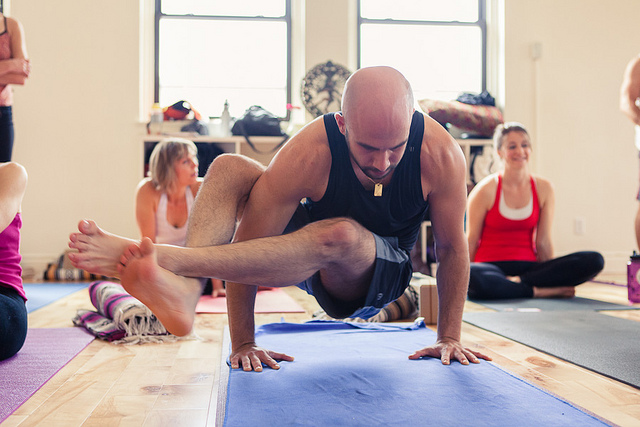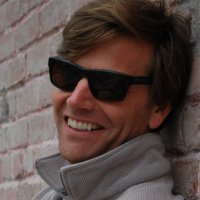I’m having a yoga crisis.
Yoga found me after a bumpy stretch of life when my psychologist said I should explore yoga to “help quiet my racing mind.”
My first yoga class was on safari in Africa; running through the bush isn’t exactly safe and the only exercise option was a yoga class. I was 8,000 miles from anyone that might make fun of me for going to yoga. So on 12/12/12 at 12:12 p.m., I began to practice. Upon my return to the United States, I committed to adding yoga into my primarily Crossfit exercise routine.
A local ambassador for Lululemon recommended the studio where my first regular practice originated. The studio was founded by two young women who practice a warm, powerful, vinyasa flow. Complete disclosure: my initial yoga selection was based almost entirely on the young, hip crowd that jammed loud MC Yogi-esque beats.
Plain and simple: it is a cool studio. Their form of power yoga is an intense workout, quiets my mind, appeals to my spiritual side, helps my posture and provides a community of super attractive people. I was hooked.
As I increasingly focused on practicing yoga, my previous Crossfit routine fell by the wayside and eventually even my running and biking (that tightened my hamstrings) was replaced with a daily yoga practice. My flexibility and core strength began to increase.
Life was good. However, the window was short.
The confusion began when I overheard one of the owners of my studio venting about “no rules in yoga” and “everyone needs to take responsibility for their own practice.” Wasn’t I paying the studio to provide some occasional instruction oversight? And if not, how exactly should I go about “taking responsibility” for my practice? Surely each pose had some guiding “rules” involved?
On a quest for instruction, I made the trek to Vermont for the Wanderlust Festival. I was promptly chastised by a Wanderlust instructor for not knowing Sanskrit for a Sun A sequence and having improper form in one of my poses. I realized her concern was valid and for the first time I missed the emphasis on movement technique that Crossfit provided. Was it possible I was safer in power lifting classes than power yoga?
As my practice continued, I visited other studios when traveling. I received instruction and adjustments on the road that I never received at my primary studio. One instructor added headstand to my practice, another gave me an adjustment in chair pose that released my neck, yet another instructor taught me to keep my arms next to my body for a sustainable chataranga…the list goes on.
Why wasn’t I hearing this at my home studio? (The one with all the attractive people.)
When I gently approached the subject with my primary instructor, I was told, “if you like what you are getting at other studios, perhaps you should be somewhere else.” But this studio and my instructors had become my friends and my community and I hated to leave.
Bruised ego in hand, I started attending more alignment based Iyengar classes at other studios on a regular basis. The gentle alignment based classes were great, but I started to feel weaker, slower and chubbier. The body that I was hoping to fine tune through yoga was being taken away by yoga. I ventured back into an intense Baptiste class only to be battered at a literally breathless speed into a strained back.
Where is the perfect practice hiding?
My mind started racing again, only now it was racing with contradictory guidance coming from various teachers. “Create the vision. Ignore the story line. Release and melt. Embrace the fire. Practice daily. Rest and listen to your body.“ Instead of quieting my mind, my practice was starting to mentally spin me out. Is this the promise of yoga? I started to question any instruction. Maybe this wasn’t for me after all.
Fortunately, right before I went off the yoga deep end, some wisdom presented itself. As I sat one morning with Zen Mind, Beginner’s Mind, this paragraph jumped out:
If you understand the cause of conflict as some fixed or one-sided idea, you can find meaning in various practices without being caught by any of them. If you do not realize this point you will be easily caught by some particular way, and you will say, “This is enlightenment! This is perfect practice. This is our way. The rest of the ways are not perfect. This is the best way.” This is a big mistake. There is no particular way in true practice. You should find your own way, and you should know what kind of practice you have right now. Knowing both the advantages and disadvantages of some special practice, you can practice that special way without danger. But if you have a one-sided attitude, you will ignore the disadvantage of the practice, emphasizing only its good part. Eventually you will discover the worst side of the practice, and become discouraged when it is too late. This is silly. We should be grateful that the ancient teachers point this out.
~ Shurnryu Suzuki
So, how do we choose the perfect practice?
My practice is finding me and it’s my job to simply observe the process. I’m being taught to learn balance, not perfection. I’m adjusting instead of quitting. I’m accepting everything has a disadvantage. My ego isn’t running my practice anymore and I’m growing with my yoga.
Love elephant and want to go steady?
Sign up for our (curated) daily and weekly newsletters!
Author: James Brearly
Editor: Catherine Monkman
Photo: elidr/Flickr











Read 2 comments and reply